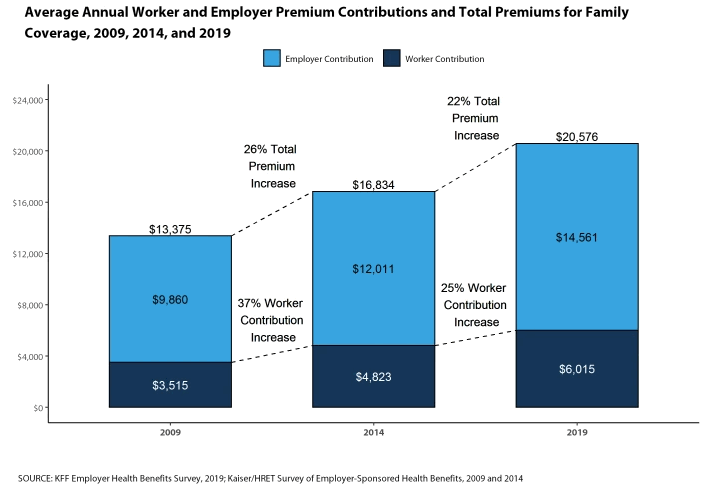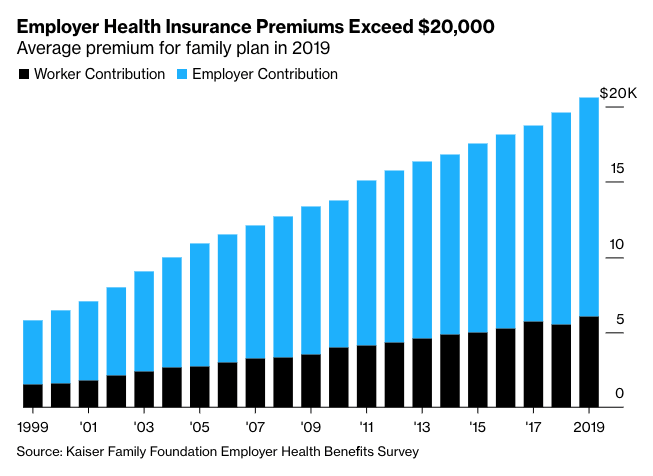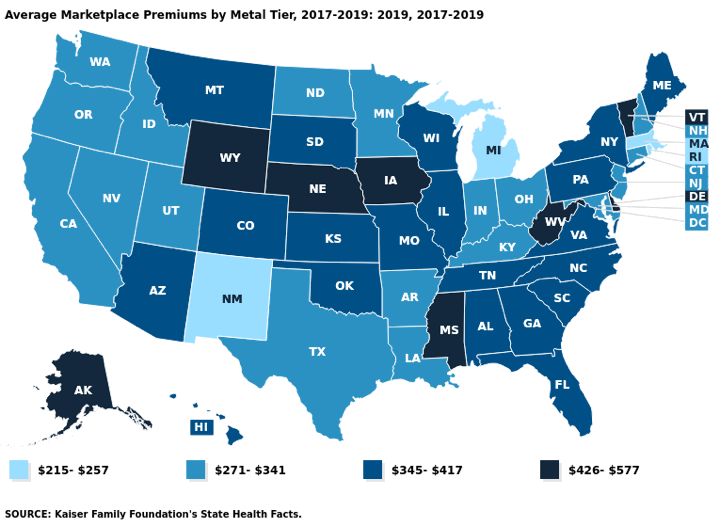
When the topic of early retirement comes up, a common question is “Are you concerned about health insurance?” I could be a cheerleader and say “nah no big deal”, but to be honest it has impacted my early retirement plans. Not only are the costs high today, but imagine how much higher they will get in the future if current trends continue.
The Kaiser Family Foundation (KFF) released the results of their annual Employer Health Benefits Survey, and the cost of family health coverage in the U.S. now tops $20,000 a year. This is more than a 50% jump from just 10 years ago:

Here’s another chart (same data set) from this Bloomberg article that goes farther back.

If you are single or a couple without kids, here’s a state-by-state map breakdown of the average monthly premium for the lowest Silver plan (per person):

The premium prices listed above don’t include deductibles and out-of-pocket expenses, which are rising as well and add up to another $2,000 per year on average:
Deductibles are rising even faster than premiums, meaning that patients are on the hook for more of their medical costs upfront. For a single person, the average deductible in 2019 was $1,396, up from $533 in 2009. A typical household with employer health coverage spends about $800 a year in out-of-pocket costs, not counting premiums, according to research from the Commonwealth Fund. At the high end of the range, those costs can top $5,000 a year.
Obviously, budgeting another $15,000 to $20,000+ in healthcare costs is going to be a huge factor to consider. Here are the ways that I have seen folks deal with this cost.
- Use an Affordable Care Act (ACA) plan and get a subsidy if your income (MAGI) is low enough to qualify. KFF has a very handy ACA subsidy calculator that will help you estimate this. If you live in California, The Finance Buff has some helpful information on the California Health Insurance subsidy. The annoying part is you never know if the rules will change on you down the road.
- Plan ahead with a job that offers health insurance benefits after you retire and before Medicare kicks in. You’ll probably have to hunker down with the same employer for a number of years.
- Save enough money (or create enough income) to pay for health insurance premiums.
- Find a part-time job that you both enjoy and offers health benefits. Employers know that health insurance is expensive, but you can negotiate benefits as part of your total compensation.
- Run a part-time side business that earns enough profit to cover health insurance costs. Look for potential group discounts or tax breaks that are available as a business instead of a consumer.
- If it works for your situation, try a high-deductible health plan (HDHP) and fund a Health Savings Account (HSA) due to the tax advantages.
- Join a direct primary care arrangement or health care sharing ministry that is exempt from ACA.
- Extend your current employer coverage for up to 18 months through COBRA (check cost).
- Move to a foreign country with reasonable and transparent cash pricing.
- Some people have bought short-term health insurance plans, but these are not ACA-compliant “full insurance”. Beware the limitations. Read the horror stories first.
- Here’s a person who gave up a promotion and quit her job to qualify for Medicaid.
Right now, we are covered by employer-sponsored health insurance, but for us it is a negotiated part of the total compensation. You can’t expect an employer to keep your same benefits package when you work less than full-time, but you can agree to take less salary in exchange for health insurance. At other times, we have bought health insurance directly. The most recent cost was around $1,600 a month for our family, very close to that $20,000 number. Even if we could qualify for a partial ACA subsidy, we would still be looking at around $10,000 a year in healthcare costs.
The difference with healthcare costs is that once you qualify for Medicare, your costs should hopefully be much less than that $20,000 a year price tag. According to BI, the national average cost for Medigap Plan F is $1,712 annually, or just under $150 a month.
So the amount you have to save to retire early depends on how many years you have until age 65. For us, that’s 25 years so that’s a big number and I don’t see how that doesn’t extend the time you need to be ready for retirement. Health insurance was definitely a factor in us going the more gradual semi-retired route.
Now imagine the overall impact that healthcare costs have on businesses, both big and small. Services and products cost more to make when every employee costs more to insure. I was able to take risks as an entrepreneur because my spouse had health insurance that covered both of us. If I had to keep my family covered with health insurance, I might still be working at MegaCorp. As Warren Buffett has said, “medical costs are the tapeworm of American economic competitiveness”. In the coming years, I wonder how both the healthcare and student loan situations will change, because the current trajectories are unsustainable.
 The Best Credit Card Bonus Offers – 2025
The Best Credit Card Bonus Offers – 2025 Big List of Free Stocks from Brokerage Apps
Big List of Free Stocks from Brokerage Apps Best Interest Rates on Cash - 2025
Best Interest Rates on Cash - 2025 Free Credit Scores x 3 + Free Credit Monitoring
Free Credit Scores x 3 + Free Credit Monitoring Best No Fee 0% APR Balance Transfer Offers
Best No Fee 0% APR Balance Transfer Offers Little-Known Cellular Data Plans That Can Save Big Money
Little-Known Cellular Data Plans That Can Save Big Money How To Haggle Your Cable or Direct TV Bill
How To Haggle Your Cable or Direct TV Bill Big List of Free Consumer Data Reports (Credit, Rent, Work)
Big List of Free Consumer Data Reports (Credit, Rent, Work)
It seems like your numbers come from the usual cheerleaders for the Rob & Pillage US Medical Industry and those that still support the ACA….which is probably the greatest obstacle to receiving care for self insured people…you know the ones who in addition to actually paying taxes have to subsidize the eternally disadvantaged by paying $600+ monthly premiums and $8000-$10,000 maximum out of pockets….
The US Medical Industry has only two goals, to bleed you dry of every cent you have by the time they let you die and engage in every form of Medicare and Medicaid price gouging. And don’t worry, if they fail to rob you of everything the Federal Reserve and Wall Street will steal the rest.
It can feel good to vent, but at the end of the day you have to take the best action available to improve your life. I don’t see anything actionable about your rant.
Thanks for addressing this issue. We are a family of 6 considering FIRE with 10-20 years before medicare (if it still exists) kicks in. If we could retire today, our healthcare costs (premiums + out of pocket) would be 40% of our expenses and represents 786k dollars of our nest egg. This amount only goes up with inflation. We don’t have that money saved and it will be while before we do – hence we continue in the rat race.
Even if we did spend the ~$16,000 per year in premiums out of our nest egg, if past history is any indication, we won’t be using it much if at all. $16,000 is a lot of money and it’s frustrating to think that we are essentially paying for a new car every year, letting it sit in storage, and then sending it to the scrap yard at the end of the year – only to start the pattern all over again the next year.
I agree. We need a new approach to health insurance in this country.
I was lucky enough to retire early in spite of my concerns about healthcare insurance. I paid COBRA premiums for the first 18 mos., then bought policies for my wife and I for about $1000/mo. total.
When ACA came along, I went online to apply, and there were three questions…family size, zip code, and household income. I was working part time by then, and had some dividend income, but was well under $10K per year. The computer told me that I was below the poverty level and qualified for Medicaid. No premiums, no co-pays, no deductibles.
At no point was I asked about assets.
There are some providers that don’t accept Medicaid, many tests need pre-approval, and I need referrals for any specialist visits.
I don’t feel guilty, as I am playing by the rules and not being dishonest. My advice would be to amass enough savings so that you can coast a few years, as savings withdrawls do not count as income.
You also have to live in a state that expanded mediaid coverage for that to work.
Great article, and a topic at the forefront of my mind when I consider early retirement. I know of retired couples who opt for an ACA plan by intentionally keeping their MAGI below the limit by carefully controlling their spending and forecasting their MAGI throughout the year.
Another family I know has negotiated full-time benefits (including health insurance) for part-time hours.
I’ve also heard of volunteer positions that compensate with health insurance in lieu of salary.
My current employer offers health insurance coverage to children up to 25 years of age.. another factor to consider if that situation applies to you.
“My current employer offers health insurance coverage to children up to 25 years of age”
All employers should, thats now the law as part of ACA
10 years ago we were in the exact same place you were thinking that rising college costs were unsustainable and hoping the bubble would burst before it kids went to college. Spoiler alert! It didn’t. Our third starts college next year. Someone is making a killing of the cost of college. But it’s the poor students who are getting “killed,” crushed under heavy debt. Protecting our kids from debt was a major factor when it came to the colleges our kids applied to.
12. Join a university (remotely) with student health insurance options.
It’s even worse than represented. I realize that my personal experience is not statistics but I’m being charged in the highest range (over $426 per person) in California. And that is not for “lowest Silver plan” – this is for Bronze HDHP.
The only PPO option available from CoveredCA is Blue Shield. I just received a notice that prepares me to the 8% increase coming in 2020. Deductible is also going up from $6300 to $6900 per person if I recall the numbers correctly. Essentially I’m paying a huge premium for emergency protection as in the normal course of action we do not get over the deductible.
I will run my comparison once enrollment for 2020 starts but from my 2019 experience there was no real alternative. There were a few HMO options available but I don’t like HMO and the premium difference was negligible.
It seems that I have two potential options to look into – group discount for small business owners if I can find one or the subsidy but I am probably over the subsidy cut-off level. If you have any other advice, I’d much appreciate it.
12. Become a student.
This is a good article. I get the health insurance question from pre-retirement people all the time. First I say, are you going to go without health insurance? Most say no but surprisingly some say they will try to whether the gap until medicare. We planned about 12k/year after retirement at 62 and we were pretty close. I used Cobra for my first 1 1/2. (I’m surprised at the amount of people that don’t understand Cobra) For the last 6 months before medicare I used a high deductible plan but I’ve been lucky so far with my health so it wasn’t a big gamble. My advice is plan ahead, you can’t go without health insurance.
Note: Our health care insurance, long term insurance, deductibles, dental work, Medicare payments average about 15K a year right now total, for both of us.
Does one have to be a full-time student or will it work to just take one course per semester?
WRT the student health insurance option, in many cases the insurance covers the University Health Center as the PCP. Also, most will require some level of credit hours before you’re eligible for coverage. Arizona State University is a minimum of 6 credit hours and accepted into a degree program or a graduate studies track .
As for health insurance thru an online university not sure how that would work since the schools are designed for part time students that have jobs. If the OP has further info it would be good to post it.
I checked our local state university. The total cost between tuition required and the health insurance adds up to about $600 per month but its a low deductible. That could be a good deal vs individual insurance for someone in their 50’s or 60’s. I checked a state university I know of inn the next state the credit requirements and tuition are higher and the total cost there is about $950/mo, so thats not so sweet of a deal.
13. Enroll annually in short term health insurance. They can be much cheaper but offer less.
Thanks, I believe that’s the same as #10 above, see linked article for the downside of that approach.
oops, you’re right, I must have read right over that one.
I live in the Bay Area and am paying less than $4.00/month for Kaiser bronze plan. That’s not a typo. we are family of 3 and the cut off income is $81K/year. I work as a consultant. If I do go over that amount then I just contribute to my solo 401K to shield the extra income. works great. I’m very grateful for ACA.
If your income is fairly low but you’re ineligible for Medicaid, New York and Minnesota offer extremely low cost (as low as $0 premiums) Basic Health Programs under Section 1331 of the ACA. Your income needs to be between 133% and 200% of the federal poverty level.
https://www.medicaid.gov/basic-health-program/index.html
In some states (California and New York for certain), state law requires the extending of COBRA benefits from the standard 18 months to 36 months.
https://www.shrm.org/resourcesandtools/tools-and-samples/hr-qa/pages/californiacalcobra.aspx
https://www.theheritagegroup.info/uploads/COBRA%20Guidelines%20for%20New%20York.pdf
People above age 40 who have not yet having reached Medicare age may want to look at ACA premiums in Vermont and New York. Those two states are pure community rated, meaning that 60 year olds get charged the same premiums as 30 year olds.
Yes, I am not sure how I will handle medical insurance if I plan to retire around 55. My wife, whom is 10 years younger than I, enjoys her work and plans to keep working until she is 60 or so. I guess I’ll be on her medical plan until I reach Medicare age. I am also maxing an HSA account for the past year (which surprisingly has been growing exponentially — not to mention the awesome triple tax benefits).
The only option that appeared to give some hope was group health insurance. I researched it tonight and realized Association Health Plans have not matured enough to be useful. They also were struck down by a district judge and I did not find any clear information whether DOL filed an appeal. At the end of the day there’s nothing but the marketplace when it comes to self-employed individuals.